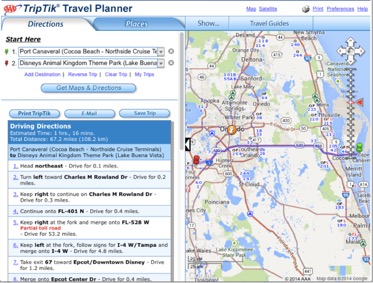“Plans are worthless, but planning is everything.” - Dwight D. Eisenhower
How many times have you heard the statement, “We need a road map to make sure we are headed in the right direction?” In fact, sometimes the business plan is described as “the road map” for the budding startup. Unfortunately, the road map as a metaphor prompts all the wrong associations for even the most promising new startup. Why? There are quite a number of reasons, including:
A road map plots the path between two known points.
Passengers in a vehicle using a road map are seldom involved in driving. The front seat passenger might offer directions from time to time. They are idle participants “on the bus.”
Following a road map becomes largely tactical, with the primary questions being: When do we get gas? When do we stop for food? How long can we last before the next bio break? See the AAA Triptik below for an example of a roadmap:
How is this metaphor a problem? We’ve already said that the most importanttask for the founding team involves navigating uncertainty rather than developing a product, finding customers, raising money, or building a team. These tasks are also important—but the primary job of the entrepreneur is simultaneously navigating uncertainty across ALL of these arenas.
How does this affect the road map metaphor?
The end point is seldom known—the journey is much more non-linear than a road map suggests, and the end points are not clearly established.
Startup navigation involves everyone who is part of the startup. Market feedback and input from everyone involved is essential—nobody is a passive passenger!
Founders must certainly pay attention to the tactics and everyday tasks, but must also constantly revisit strategic direction and next steps (what we refer to as the Now, the Next, and the Navigation in the book).
So how do we define strategy for a new startup, and what is a better metaphor? First, we define strategy as “the process of linking today’s choices and actions to tomorrow’s destination, under uncertainty.“ Let’s unpack the key components of this definition:
Process. Strategy-making is a process, not an outcome. It is not the 100-page business plan that sits on the shelf gathering dust—it is an iterative and adaptive approach to navigating uncertainty. As Eisenhower noted, it is not the plan but the planning that is essential.
Destination. There has to be a vision for where the startup is heading to guide and inspire internal and external stakeholders (employees, partners, investors, and others).
Choices and actions. While strategy does include an ultimate destination, that destination needs to be connected back to individual actions. This is not just the founder(s) and leadership team—all employees must understand how their choices and actions affect the startup’s trajectory.
Uncertainty. Little is known or guaranteed about the direction and market for a startup. The hypotheses and relationships between cause and effect, impact of competition, customer acceptance, technological performance, and funding create an ever-changing landscape where both possible outcomes and probabilities of those outcomes are largely unknown.
With this definition, a far better metaphor for the startup journey is a set of sailing instructions. There is still a paradise island (destination) to motivate and inspire all involved. But everyone aboard is also monitoring winds and currents (choices and actions like market traction, revenue growth, renewals) as well as storms (uncertainties like competitors, regulations and technological changes) that create challenges. And the entire crew is involved in constant adjustment and adaptation to make sure the ship continues to make progress (choices and actions).
Navigating the Strategy Ocean
Vision and strategy are elusive concepts—but appropriate metaphors and an understanding of how to navigate uncertainty can help keep the startup ship on course sailing to the promised land!Look for sailing instructions like the navigation chart above in our book, The Titanic Effect: Successfully Navigating the Uncertainty that Sink Startups.
If you are already getting excited for the book, check out where you can pre-order The Titanic Effect by clicking the book title. Subscribe to our mail list below, and you’ll get these weekly tips sent right to your inbox.


